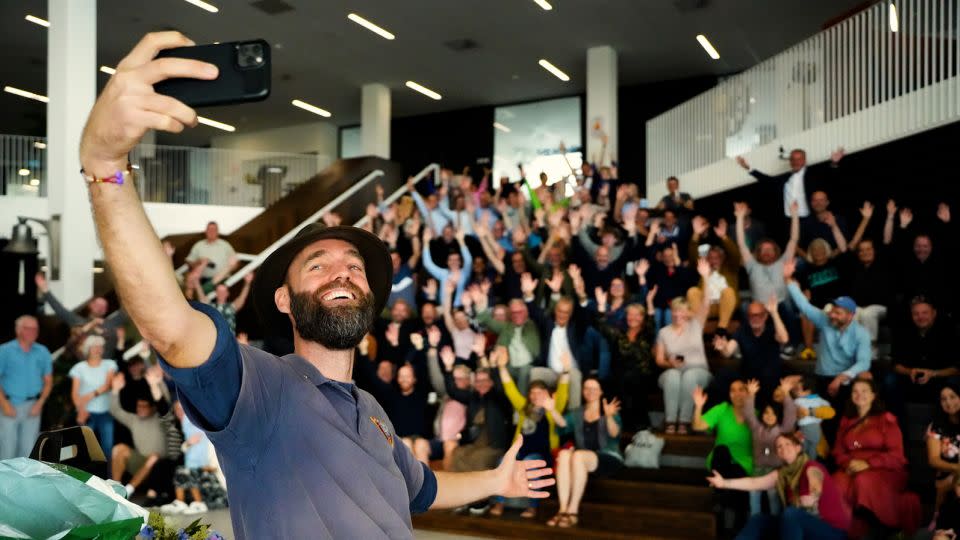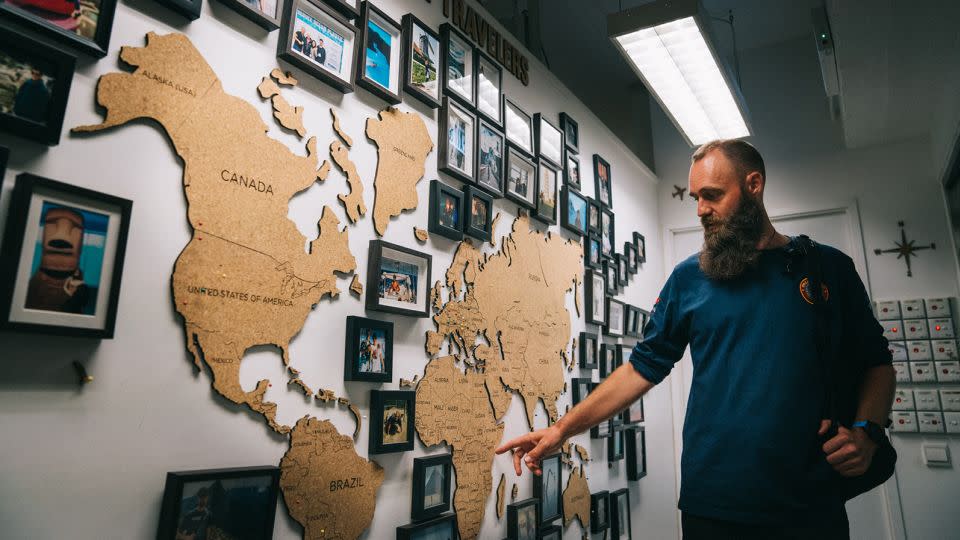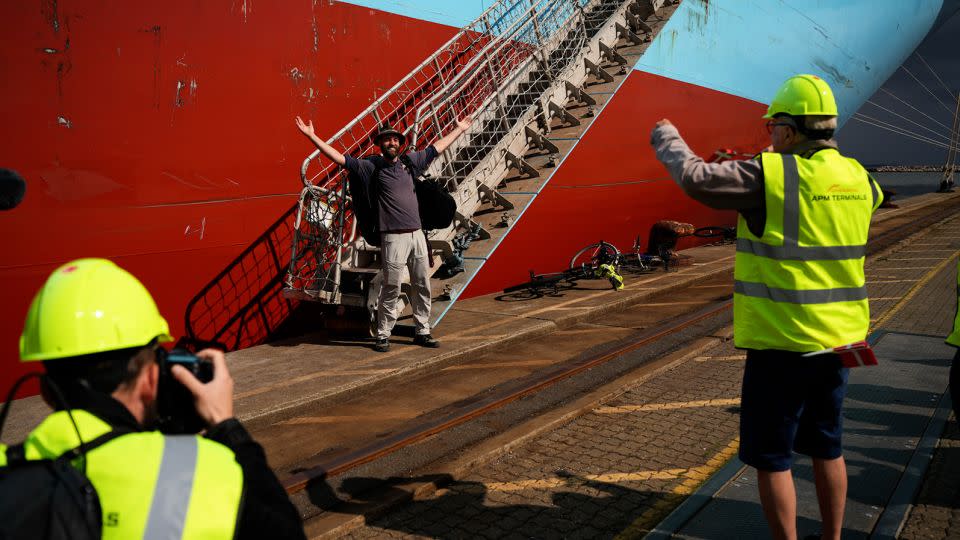Man who visited every country without flying has finally returned home
On October 10, 2013, Torbjørn “Thor” Pedersen left his job, girlfriend, and family behind in Denmark to embark on an epic journey.
His goal? To visit every country in the world without flying.
Pedersen set a couple of rules for himself. He’d spend at least 24 hours in each nation and resist returning home until he finished.
He’d also do his best to keep costs low and live off a budget of roughly US$20 a day.
On May 24, that day finally came. After nearly ten years of travel, Pedersen successfully visited his 203rd and final country, the Maldives, and began his long-awaited voyage back to Denmark.
It would have been easier to fly, of course, but Pedersen wanted to bring the project full circle.
“There’s a historical sense of returning home by ship – people can see it on the horizon and stand and wave as I come down the gangway,” Pedersen, who has been traveling as a goodwill ambassador for the Danish Red Cross, tells CNN Travel. “And that seems like an appropriate way to complete the project.”
After celebrating in the Maldives, the 44-year-old backtracked to Malaysia via Sri Lanka to board the massive MV Milan Maersk – a container ship stretching roughly 1,310 feet long, or about the size of 3.6 soccer fields – for the 33-day voyage home.
“In my cabin, I looked out the porthole in Malaysia, and it dawned on me that every day the view would gradually change until it finally became Denmark,” says Pedersen.
“Even if I broke my leg at that point, I would make it home. There are no more snakes, wild dogs, malaria, or visas to secure – I just had to avoid falling overboard!”
An emotional homecoming
On July 26, Pedersen walked down the gangway at the Port of Aarhus, on Denmark’s eastern coast, where roughly 150 people were waiting for him to celebrate.
Among the cheering crowds were his wife Le (Pedersen proposed to his girlfriend atop Mt Kenya in 2016 and they married in 2021), father, siblings, friends, project partners and many supporters who have been following his blog, Once Upon a Saga, and social media channels.
“I’ve seen many tearful eyes since I got back – people have come up to hug me sobbing,” says Pedersen. “I have also received a lot of gifts – Danish beer, milk, foods – and got to meet people who have been following my social media from Colombia, Australia, Norway… that was amazing.”
While fielding a deluge of calls, messages, and interview requests, Pedersen has been catching up with family at his father’s house.
He’s also savoring all little things – like the clean and cool Danish air, morning runs with Le, and ice-cold Danish milk at every opportunity.
“My family is really proud. There’s a lot of love,” he says. “Coming home is something I’ve been focusing on – something I’ve wanted to materialize for the longest time. But I am still processing that the journey is over and figuring out what comes next.”

Ten years of travel
Before taking off in 2013, Pedersen worked in shipping and logistics, which turned out to be invaluable expertise when planning the complex route and adapting on the road.
In fact, he didn’t veer much from his original plan, aside from a few surprises. For instance, he overlooked Equatorial Guinea, one of the world’s most difficult countries to access. After four months and many failed attempts, Pedersen finally acquired a visa. Even though land borders were closed at the time, he was able to cross thanks to a serendipitous encounter with a stranger who worked in Equatorial Guinea and offered him a ride.
Later, Pedersen thought he could acquire a Chinese visa at the border with Mongolia and then travel to Pakistan. But due to the long processing time, he had to backtrack nearly 7,500 miles through several countries to get to Pakistan before his visa expired.
All the while, time started to add up. He had originally anticipated it would take four years to reach 203 countries (the UN recognizes 195 sovereign states, but Pedersen included partially recognized states, too), but the world had other plans.
During his years on the road, Pedersen endured months-long visa delays in places like Syria, Iran, Nauru, and Angola.
He also overcame a severe bout of cerebral malaria in Ghana, survived an intense four-day storm while crossing the Atlantic from Iceland to Canada, navigated shuttered land borders in conflict zones, and had to reschedule many sailings due to broken-down ships or exhausting bureaucracy.
The most significant delay was the COVID-19 pandemic.
In early 2020, the intrepid traveler suddenly found himself stuck in Hong Kong for two years with just nine countries left.
“I look back at Hong Kong, and it’s a bit of a paradox. It was the worst time of my life and the best time of my life, somehow. I had to cope with the situation – it was such a struggle to work out if I should abandon this project nine countries short of completion,” Pedersen recalls.
“I had to ask myself: how much of my life will I give to this? But while waiting for the world to open, I made a life in Hong Kong and forged so many special relationships.”
Pedersen stayed sane by cooking dinner with friends, hiking the city’s many trails, working with the Red Cross, giving motivational speeches, and working at the Danish Seamen’s Church.
Having acquired an employment visa and Hong Kong residency, Pedersen married his fiancé, Le, who was back in Denmark, via a US-based virtual wedding service.
It wasn’t how the couple envisioned their big day, but the decision enabled Le to become a resident and visit Pedersen (Hong Kong prohibited foreign travelers at the time).
“We spent 100 days together, which was wonderful,” he recalls, adding that it was their longest stretch of time together since Pedersen left Denmark in 2013. “She got to meet my friends and understand my life. We love hiking in Hong Kong and did the MacLehose Trail, which is 62 miles long at more than half the elevation of Mount Everest, side by side in one go.”
The journey resumes
On January 5, 2022, Pedersen was finally able to leave Hong Kong and continue across the Pacific.
His first stop was Palau. Behind the scenes, it took six months of negotiation with the Palau government to let him arrive via container ship, he says.
After 15 days at sea, Pedersen spent eight of his 14 days in Palau in hotel quarantine due to an outbreak on the island.
Next came a 16-day journey back to Hong Kong, where he returned to hotel quarantine for another two weeks.
About a month later, he continued on to Australia, then New Zealand, Samoa, and Tonga – but not without immense effort.
“I had to plead with almost every government. For Tonga, we were in touch with the health ministry, navy, and military. No one wanted to say yes and go against the prime minister [because the country was in a state of emergency due to COVID],” says Pedersen.
“Finally, one night, I got an email from the prime minister that simply said, ‘It’s okay, let him in.’”
After Tonga, Pedersen went to Vanuatu, where Le joined him again so they could marry in person.
Their wedding planner invited all the resort guests and staff, who made incredible decorations from palm leaves and drew huge hearts adorned with seashells in the sand.
“It was just beautiful – the staff was sweet and giddy, and they made it really special,” says Pedersen.

The final three
Pedersen set off for the last country in the Pacific, Tuvalu, wary of the logistics.
Home to nine islands and just 11,600 people, Tuvalu is one of the world’s smallest and most remote nations, so it can be tough to get spare parts for boats.
“It is gorgeous. The surf is amazing, the sky is beautiful, and the people were so kind and helpful,” he says. “But I didn’t expect to be there for two months.”
“The ships kept breaking down. One of them had a leaking hole in the hull. I tried to get on another ship, but it just never set off.”
Finally, Pedersen managed to return to Fiji on a tugboat. From there, a 24-day journey on a container ship took him to Singapore, where Le joined him to devour food at hawker centers, explore the National Museum, hike the MacRitchie Nature Trail, and run along the Singapore River.
After she returned to Denmark, Pedersen crossed the land border to Malaysia and caught a ship to Sri Lanka before setting sail to the final country: the Maldives.
When Pedersen arrived at the port in Malé, the capital, he spotted a group of people waving waving small Danish flags alongside one of his sponsors, Ross Energy, and friends like record-setting Norwegian traveler Gunnar Garfors (the first person to visit every country in the world twice), who came to help him celebrate.
“When I was in the Maldives, it was enormously hectic, and I had no real time for reflection,” he says. “I was mentally exhausted – it has been a roller-coaster of emotions.
“There’s uncertainty while I am traveling, but I have been in operational mode for so long now that it feels somewhat safe to me. There’s a different kind of uncertainty when I get home. I will be free to do whatever I want, go anywhere, or go nowhere.”
Traveling with purpose
From start to finish, Pedersen tallied up some incredible statistics during his travels: 3,576 days, 37 container ships, 158 trains, 351 buses, 219 taxis, 33 boats and 43 rickshaws.
He crossed 223,000 miles, or the equivalent of nine journeys around the Earth – and that’s not including the long voyage home.
But it’s not about the numbers, says Pedersen.
It’s about celebrating the kindness of people and sharing a positive outlook on the world.
“I set out on this journey with a motto, ‘A stranger is a friend you’ve never met before,’ and I have been shown time and time again that this is true,” he says. “If you engage with people, they’re usually all in.”
Pedersen says he’s met warm, friendly, helpful people all around the world, many of whom offered him tea, meals, introductions, translation support, or simply provided directions.
“I stayed in the homes of many, many strangers during my travels, and I made it through every country in the world – the ones with armed conflict, the ones with virus outbreaks – unharmed,” he exclaims.
“Either I’m the luckiest man on the planet, or the world is in a much better place than most people are led to believe by the scary, dramatic news on social media and news channels.”
The journey is also a testament to Pedersen’s perseverance. He came close to quitting a few times but refused to throw in the towel.
“Someone wrote me today that I won first, second and third prize in stubbornness,” laughs Pedersen. “There’s always been a solution. I just had to look really hard for it sometimes.”
His dogged determination mentality comes from a desire to show supporters they can do anything they put their minds to.
“I had the craziest of goals. And if I could do this, you can lose weight or learn to play an instrument, learn a language, get an education, get a job… whatever you want.”

What’s next?
His final sail aboard the MV Milan Maersk journeyed across the Indian Ocean to the Red Sea, across the Suez Canal, into the Mediterranean, up the English Channel, over to Germany, and finally, to Denmark.
“I haven’t processed that this project has ended yet. They say that if you want to incorporate a new habit in life, you must repeat it for 30 days. I’ve been doing this for more than 3,500 days. So, this is very much who I am now,” says Pedersen.
After he’s had time to rest and regain his footing, Pedersen plans to trade in his life of perpetual travel and move forward in other ways.
For starters, he looks forward to spending more time with his wife and starting a family together.
“We have a lot of things to celebrate. While I was traveling, she accomplished so many things – she completed a medical degree, finished her PhD, started working at a pharmaceutical company, got a promotion, completed two full Ironman [triathlons]… she’s a superwoman.”
As he embarks on a new chapter, Pedersen is also working with Canadian filmmaker Mike Douglas to wrap up “The Impossible Journey,” a documentary on the project, and plans to write a book about the journey.
Looking ahead, he hopes to channel his experiences into speaking engagements – a skill he’s honed over the past 10 years.
“It dawned on me that I wasn’t comfortable going on the stage when I left home. But now, I can walk on a stage in front of 300 people smiling,” he says.
“The journey helped me identify my strengths – and engaging with people is one of them. Hopefully, through speaking engagements, I can make a living by out of making people laugh, learn, and inspiring them to never give up.”
For more CNN news and newsletters create an account at CNN.com

